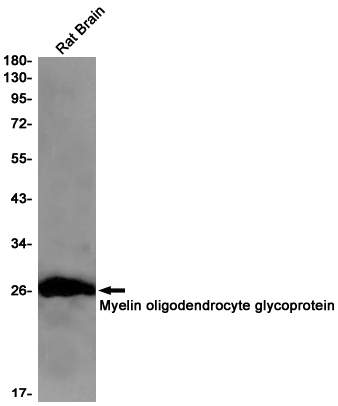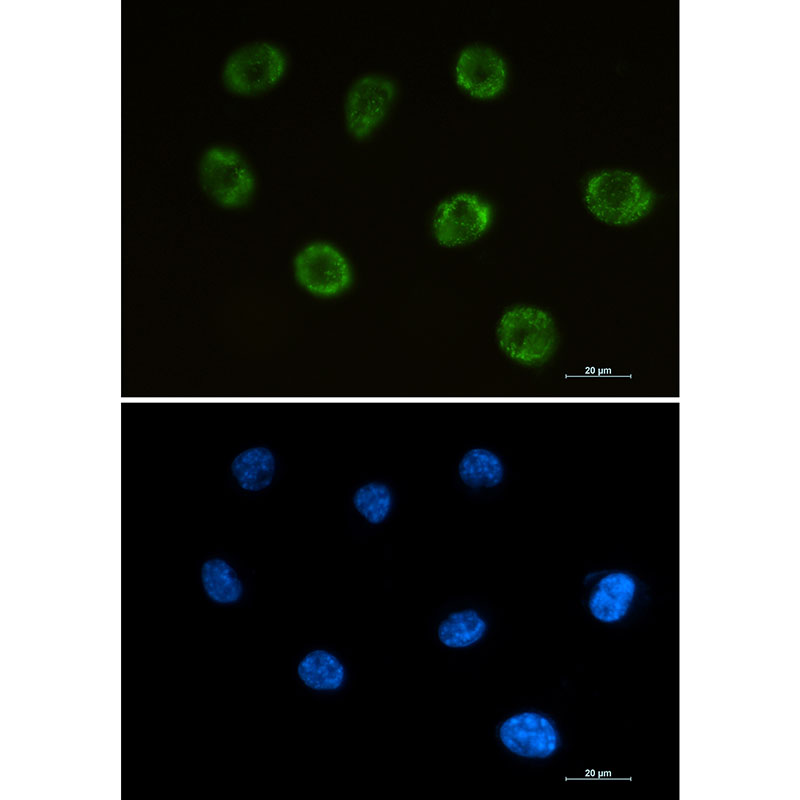

| WB | 1/500-1/1000 | Rat |
| IF | 咨询技术 | Rat |
| IHC | 咨询技术 | Rat |
| ICC | 1/50-1/200 | Rat |
| FCM | 咨询技术 | Rat |
| Elisa | 咨询技术 | Rat |
| Aliases | BTN6; BTNL11; MOGIG2; NRCLP7 |
| Entrez GeneID | 4340 |
| WB Predicted band size | Calculated MW: 28 kDa; Observed MW: 28 kDa |
| Host/Isotype | Rabbit IgG |
| Antibody Type | Primary antibody |
| Storage | Store at 4°C short term. Aliquot and store at -20°C long term. Avoid freeze/thaw cycles. |
| Species Reactivity | Rat |
| Immunogen | A synthetic peptide of human Myelin oligodendrocyte glycoprotein |
| Formulation | Purified antibody in TBS with 0.05% sodium azide,0.05%BSA and 50% glycerol. |
+ +
以下是关于MOG抗体相关研究的3篇代表性文献示例(注:内容基于学术知识库整理,建议通过学术数据库获取全文验证):
---
1. **文献名称**:*MOG antibody-associated encephalomyelitis: A distinct inflammatory CNS disease*
**作者**:Jarius S, et al.
**摘要**:本研究首次提出MOG抗体相关脑脊髓炎(MOG-EM)为独立疾病实体,区别于多发性硬化(MS)和AQP4抗体阳性的视神经脊髓炎(NMOSD)。通过分析患者临床特征,发现MOG-EM更常见于儿童和年轻成人,表现为视神经炎、横贯性脊髓炎或脑炎,且对免疫治疗反应较好。
---
2. **文献名称**:*Antibodies to MOG and AQP4 in adults with neuromyelitis optica and suspected limited forms of the disease*
**作者**:Reindl M, et al.
**摘要**:研究比较了成人NMOSD患者中MOG抗体与AQP4抗体的分布及临床差异。结果显示,MOG抗体阳性患者更易出现双侧视神经炎和脑部病变,而AQP4抗体阳性者脊髓受累更严重。提出MOG抗体检测对鉴别诊断和治疗选择具有重要意义。
---
3. **文献名称**:*Pathogenicity of human antibodies against myelin oligodendrocyte glycoprotein*
**作者**:Höftberger R, et al.
**摘要**:通过动物模型和体外实验,验证了人源MOG抗体的致病性。研究发现,MOG抗体可直接结合髓鞘,引发补体依赖性脱髓鞘和炎症反应,且病理特征与MS不同,支持MOG抗体相关疾病作为独立疾病分类。
---
**扩展建议**:如需更多文献,可检索关键词“MOG-IgG”、“MOGAD”(MOG抗体相关疾病)或参考2023年更新的国际诊断共识(如Ramanathan等学者牵头发布的诊断标准)。
**Background of MOG Antibodies**
Myelin oligodendrocyte glycoprotein (MOG) antibodies are autoantibodies targeting MOG, a protein expressed on the surface of oligodendrocytes and myelin sheaths in the central nervous system (CNS). Historically, MOG antibody-associated disease (MOGAD) was often misclassified as multiple sclerosis (MS) or neuromyelitis optica spectrum disorder (NMOSD) due to overlapping clinical features. However, the identification of MOG-IgG as a distinct biomarker in the 2000s led to its recognition as a separate disease entity.
MOGAD primarily manifests as optic neuritis, transverse myelitis, or acute disseminated encephalomyelitis (ADEM), often with relapsing-remitting courses. Unlike AQP4-IgG-positive NMOSD, MOGAD typically shows better recovery after attacks and a lower relapse rate. Pathogenic mechanisms remain unclear, but MOG antibodies may directly damage myelin via antibody-dependent cellular cytotoxicity or complement activation.
Diagnosis relies on cell-based assays (CBA) to detect MOG-IgG in serum, combined with clinical and MRI findings. Treatment involves acute-phase corticosteroids and long-term immunosuppressants (e.g., rituximab, IVIG), though evidence-based guidelines are evolving. Research continues to explore MOG antibody pathogenicity, optimal therapies, and long-term outcomes.
×